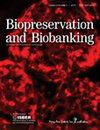Shipment of Glycerolized RBC Segments for Red Cell Concentrate Compatibility Testing.
IF 1.4
4区 生物学
Q4 CELL BIOLOGY
引用次数: 0
Abstract
Background: Red cell concentrate (RCC) cryopreservation allows for long-term storage of RCCs with rare phenotypes. Currently, tubing segments are not produced for these frozen units. Pre-transfusion compatibility testing therefore requires thawing and deglycerolization of the whole unit. A study was conducted to demonstrate the feasibility of using segments for compatibility testing, including circumstances where segments would require shipment to a reference laboratory. Study Design and Methods: RCCs produced using the red cell filtration method from citrate-phosphate-dextrose whole blood collections were glycerolized (40%) at day 21 post-collection and segments were generated prior to freezing. Room temperature (RT, 18°C-20°C) or water bath (WB, 37°C) thawing of segments was performed prior to storage at RT or at refrigerated temperatures (cold, 1°C -6°C) for 0, 24, 48, or 72 hours followed by deglycerolization and hemolysis testing. Additional segments were thawed and shipped in temperature-controlled containers at either RT or 1°C -10°C for antibody screening. Results: Hemolysis and RBC recovery results did not show significant differences over the storage period or between thawing and storage conditions. RBC recovery ranged from 46% to 64%. Hemoglobin (Hb) recovery ranged from 56% to 96%; for RT-thawed segments, recovery was significantly higher at 24 hours and lower at 72 hours for RT storage compared with cold storage. WB-thawed, cold-stored segments had higher Hb recoveries at 48 hours. Phenotype assessment was successful for all segments regardless of thawing method or shipping condition. Discussion: The shipment of thawed segments containing glycerolized red cells is feasible for the purpose of conducting pretransfusion phenotype evaluations or pretransfusion compatibility checks.装运甘油化红细胞片段,用于红细胞浓缩物兼容性测试。
背景:红细胞浓缩物(RCC)冷冻保存允许长期储存具有罕见表型的 RCC。目前,还没有为这些冷冻单位生产管段。因此,输血前兼容性测试需要对整个单元进行解冻和脱甘油处理。我们进行了一项研究,以证明使用管段进行兼容性测试的可行性,包括需要将管段运送到参考实验室的情况。研究设计与方法:使用红细胞过滤法从柠檬酸盐-磷酸盐-葡萄糖全血中采集的红细胞,在采集后第 21 天进行甘油化(40%),并在冷冻前生成片段。在室温(RT,18°C-20°C)或水浴(WB,37°C)解冻血块,然后在室温(RT)或冷藏温度(cold,1°C-6°C)下保存 0、24、48 或 72 小时,随后进行脱甘油和溶血检测。其他片段解冻后装入温控容器,在室温或 1°C -10°C 下运输,以进行抗体筛选。结果:溶血和红细胞回收率结果在储存期间或解冻与储存条件之间没有明显差异。红细胞回收率在 46% 到 64% 之间。血红蛋白(Hb)的回收率在 56% 至 96% 之间;与冷藏相比,RT 解冻的血块在 24 小时内的回收率明显较高,而在 72 小时内的回收率较低。WB解冻、冷藏片段在48小时时的Hb回收率较高。无论解冻方法或运输条件如何,所有片段的表型评估都是成功的。讨论运输含有甘油化红细胞的解冻片段可用于输血前表型评估或输血前兼容性检查。
本文章由计算机程序翻译,如有差异,请以英文原文为准。
求助全文
约1分钟内获得全文
求助全文
来源期刊

Biopreservation and Biobanking
CELL BIOLOGY-MEDICAL LABORATORY TECHNOLOGY
CiteScore
3.30
自引率
12.50%
发文量
114
审稿时长
6-12 weeks
期刊介绍:
Biopreservation and Biobanking is the first journal to provide a unifying forum for the peer-reviewed communication of recent advances in the emerging and evolving field of biospecimen procurement, processing, preservation and banking, distribution, and use. The Journal publishes a range of original articles focusing on current challenges and problems in biopreservation, and advances in methods to address these issues related to the processing of macromolecules, cells, and tissues for research.
In a new section dedicated to Emerging Markets and Technologies, the Journal highlights the emergence of new markets and technologies that are either adopting or disrupting the biobank framework as they imprint on society. The solutions presented here are anticipated to help drive innovation within the biobank community.
Biopreservation and Biobanking also explores the ethical, legal, and societal considerations surrounding biobanking and biorepository operation. Ideas and practical solutions relevant to improved quality, efficiency, and sustainability of repositories, and relating to their management, operation and oversight are discussed as well.
 求助内容:
求助内容: 应助结果提醒方式:
应助结果提醒方式:


